New Zealand is the first country in the world where women gained the right to vote, and is rightly proud of its suffragist heritage. New Zealand women were legally allowed to vote from 19 September 1893, and the first election following that, on 28 November 1893, saw 2 out of 3 adult women in the country vote.
The campaign for the vote, led by women like Kate Sheppard, Meri Te Tai MangakÄhia, Harriet Morison (the namesake for my 1893 sewing machine), Helen Nicol, and others, was motivated by the belief that all women should have the right to vote – irrespective of their wealth, education, or race.
New Zealand has been far from perfect in respect to gender and racial equality, but the ideals behind the campaign, which included a petition signed by a quarter of the women in New Zealand, is one of the bright spots in New Zealand history.
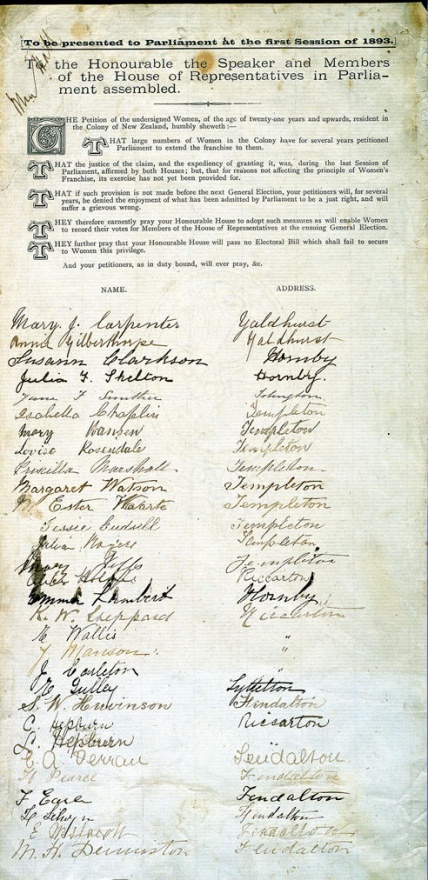
Kate Sheppard, as one of the primary leaders of the movement, is often used as a symbol of the suffrage movement. Her portrait is featured on the $10 bill, along with the white camellia, the suffragists symbol. The most prominent suffragist memorial in New Zealand is named after her. The green pedestrian crossing lights in the streets around Parliament feature Sheppard, instead of a generic walker.
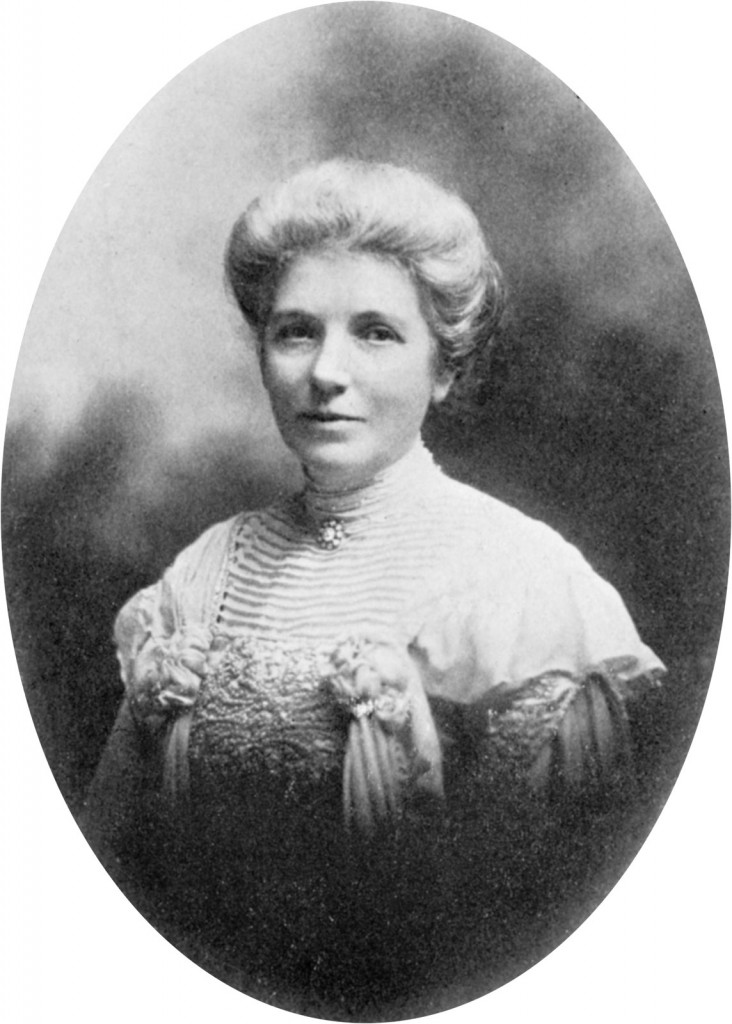
In 2019 the New Zealand government bought the Kate Sheppard House, where Kate lived during the most active and influential part of her life, to turn into a museum to tell the story of the suffrage movement in New Zealand.
And the new museum, in turn, asked me if I could make a garment to represent Sheppard and the suffragists!
We initially discussed recreating the Arts & Crafts evening dress/tea gown she wears in the portrait features on the $10 note. The extant garment, somewhat altered from its original state, is in the collection of the Canterbury Museum. However, the dress was too complicated a project for the museums making timeline, and didn’t fit nicely into the space.
Instead, I suggested a shirtwaist.

Why a Shirtwaist?
In addition to fitting the making schedule and the space beautifully, shirtwaists are more representative of the movement as a whole than of just Sheppard. As admirable a figure as Sheppard is (unlike many famous overseas suffragists and suffragettes there are few problematic aspects to her life or beliefs), she’s not monolithic. The progress that was made for New Zealand women was as the result of many workers. Their achievements shouldn’t be overshadowed by one person. So a garment that speaks for the movement as a whole is a fitting tribute.
Many of the suffragists who canvassed for signatures for the famous petition probably wore shirtwaists as they went door to door asking for votes. Photos of women voting in the 1893, 96 and 99 elections in New Zealand show them in shirtwaists.

Shirtwaists should be the iconic symbol of the late 19th and early 20th century women’s rights movement. Unlike colour schemes, sashes, and banners, they were worn by every women exercising their right to a more liberated life. Shirtwaists were the original classless garment. ‘Typewriters’ and factory workers wore them as their daily work uniform, but the wealthiest women of leisure wore them for outdoor pursuits, under suits, and as tasteful informal wear.
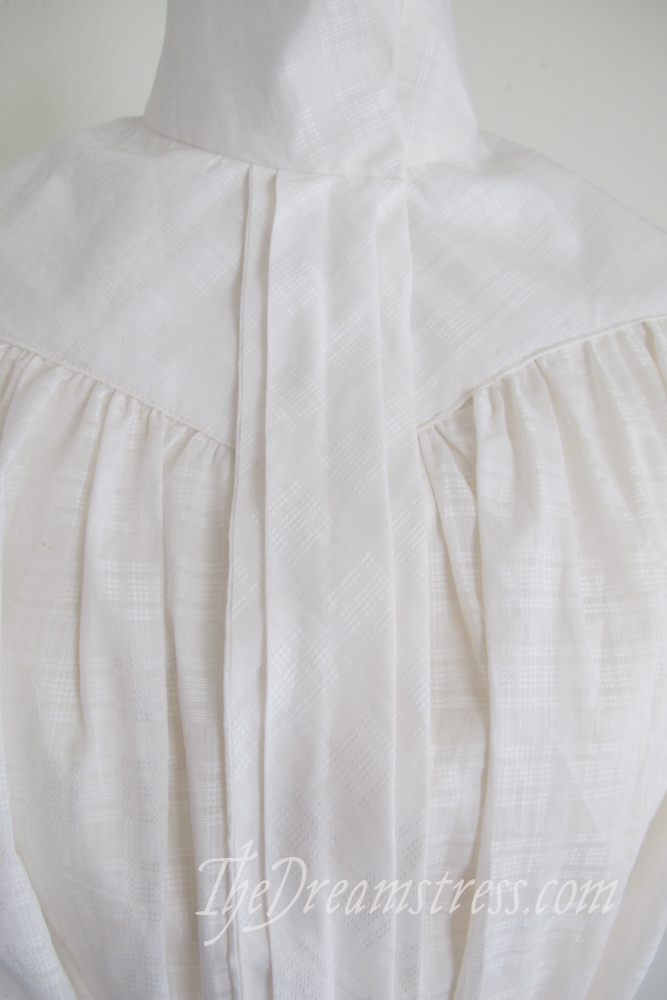
Their adoption as an indispensable part of a women’s wardrobe did as much to liberate women’s dress as the acceptance of trousers 40 years later. Often made of cotton, shirtwaists were affordable, and washable. They allowed poorer woman to be neatly and acceptably dressed for a much wider range of activities. Mix and match outfits involving shirtwaists were much less expensive than whole dresses. Three shirtwaists and one nice skirt and you could be clean and presentable every day of the week. Front fastenings meant women could dress themselves, and thus live alone, and be well dressed without a maid.
Looser fit meant that they could be readymade, instead of custom fitted, making them cheaper, and easier to make yourself. Looser fit also allowed more physical activities: depictions of everyday women in athletic pursuits in the 1890s and 1900s often show them in shirtwaists. Shirtwaists levelled social barriers both in terms of class, and in terms of restrictions.

The Making:
I used a period 1890s drafting manual for my shirtwaist, and based the design details on depictions of women in 1890s photos of the New Zealand National Council of women. I was particularly inspired by the lighter coloured waist worn by the woman fourth from left, top-ish row, next to the woman with the cape:

Sheppard is seated at centre, in the light blouse and dark jacket.
The women who made up the National Council of Women would have been wearing their daytime best for the Council photos. In consultation with the exhibition designers we chose a less formal fabric, and a less formal shirtwaist. It is meant to look like one which might have been worn while canvassing, or to a simpler working meeting.

We settled on a crisp cotton with a subtle woven-in check. It’s a fabric that will hold its body over time, and has enough texture and visual interest to be dynamic as a display piece. (In the small world of Wellington fabric, my friend Nina has a Regency dress made from the same fabric)

I chose a more formal, structured construction, with a fully fitted inner lining. I felt this was more representative of the transitional shirtwaists of the early 1890s, and would help the shirt to remain its shape on display.
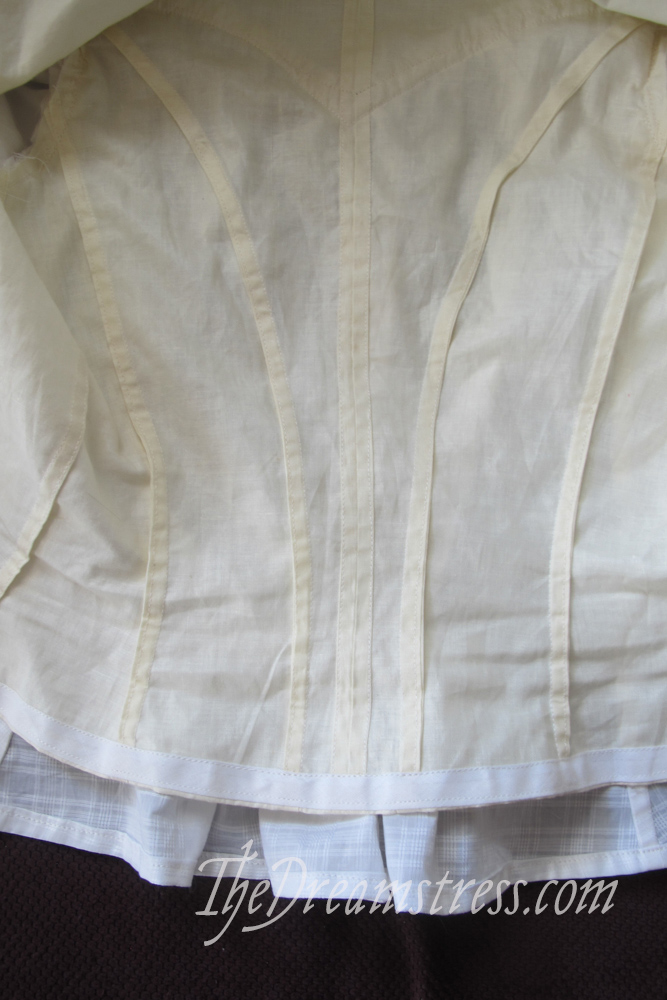
My construction methods were a mix of historical methods, and museum-suitable ones chosen for longevity and durability.

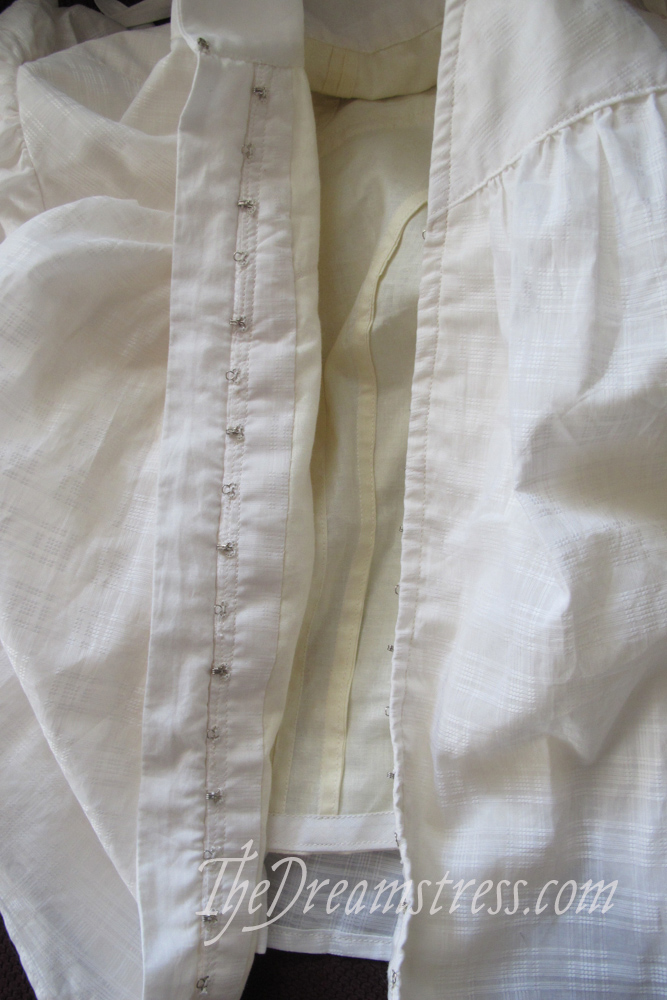
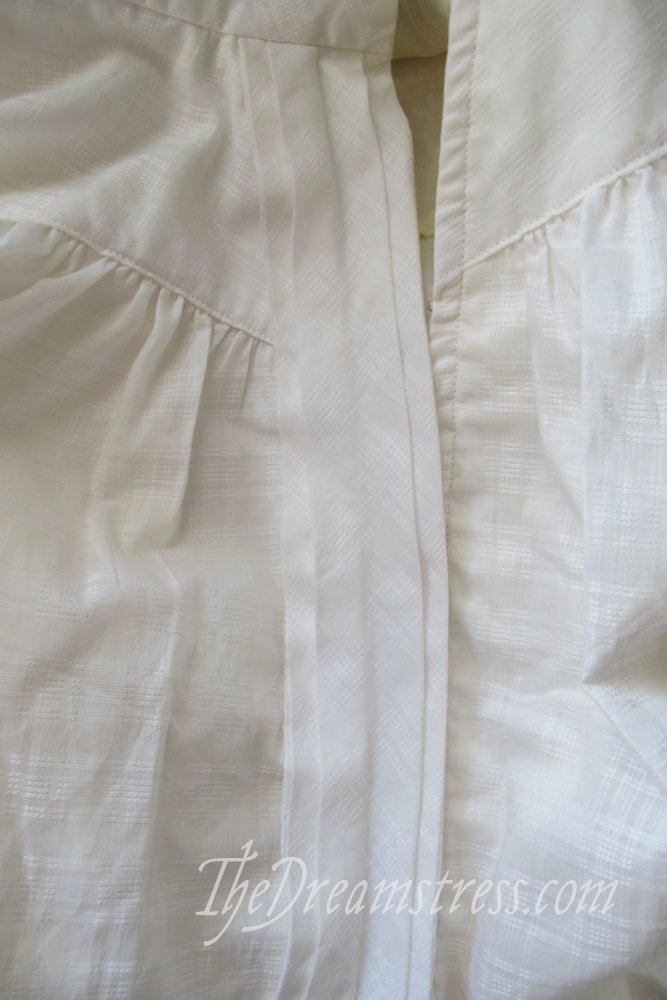
I’m incredibly honoured to have been asked to create a piece representing this part of New Zealand’s history, and to be able to help to tell this story.
An odd person said to me that it was weird they asked me, because I’m not a Kiwi. I may not have the accent, but this is my home. Like Sheppard, I’m an immigrant who moved here as a young adult. And like Sheppard, I’d like to make my country a better, fairer place.


This is heartwarming and informative – thank you Leimomi. I look forward to the day I can visit the Kate Sheppard House and see your shirtwaist.
How interesting, thank you for sharing this story. And there is always an “odd person” waiting to rain on parades with weird divisive questions, isn’t there?
ceci
how lovely! i can’t think of a more suitable garment to represent the suffragists, as you say. pretty, practical, and universal. i am happy the museum engaged you to do this, and that you shared it here.
What a wonderful explanation of the significance of the shirtwaist!
Yes! I felt the same way! And not just the explanation of the shirtwaist, but also the parts about making a museum display with intention. I loved it! So informative!
I hope that the odd person asked neutrally, and not judgingly.
The US had to recently reckon with the exact concept in our most recent election: Who is an American? ie: Who belongs in America? Who is allowed to opine and lead? Who is allowed to have their contributions acknowledged? I am so glad at the outcome.
This is a great project! Congratulations for being chosen to make the piece, which is lovely and perfect for the reasons you’ve described here. Thanks for sharing this with us!
Congratulations on such Prestigious commission & such beautiful results!!!!!!
That’s a wonderful garment connected to a wonderful history. 🙂
Out of curiosity, which drafting manual did you use?
I just love this story. It is just so great to see garments for working class women and especially those politically active women who carved out our rights so long ago. I think you are a fecking legend, Dreamstress, so don’t even give that ‘odd’ one any more air space. Keep up the wonderful work.
That is lovely. I wouldn’t worry about it. I am not a kiwi either and do not wish to be but I am a New Zealander and belong to this beautiful land Aotearoa
I am so happy to see this shirtwaist, and to see the details of construction. You place the shirtwaist’s importance in history so well. The song of the shirtwaist, no less. While I love seeing people’s ‘best’ clothes, the evening dresses, the fancy decorations, my heart goes more and more to wondering what ‘real’ people wore, how they managed to launder their clothes, and to live in them from day to day. Yes, three shirtwaists (maybe one with a little lace for Sunday) and a dark wool skirt, and a woman could be respectable and tidy.
The little bit of puff in the sleeves (which we love) makes the shirtwaist that much more wearable. You could lift your arms up without dragging the shirtwaist out of the skirt. So a schoolteacher could write on the blackboard, conduct the singing, and reach the rolled up map down from the top shelf. The tie round the middle helps you to adjust fullness so that the shirt sits nicely before you fasten the skirt waistband over the top, and it helps to keep the shirt from pulling out. (It really does!) The pretty features like the point in the yoke at the back and the pleated strip down the front that hides the fastening add grace and smartness.
I do like the fabric, with its faint texture, and was intrigued to see the fitted lining. Is it attached to the main garment? Beautiful work! May it last many, many years!
Yay for shirtwaists! I would love to have a wardrobe of historical simplicity, with a few shirts in different colours and a couple of skirts (hello, Fantail) and a nice jacket to wear with them. Something to work toward, though it will be many years yet before I am up to jacket-making – or fully lined shirtwaist-making, to judge by the pictures above!
It’s weird the ideas people have of what makes someone Kiwi. I was born in this country, as were my parents before me, but I grew up elsewhere. Am I a Kiwi? To others? To myself? On the outside? On the inside? In part? Does it even matter?
I could understand someone being peeved if local talent had been overlooked in favour of outsourcing to some unrelated country, but you are local.
What a great opportunity! It’s so neat that you were able to make a garment that will be on display and hopefully prompt conversations and thoughts about the many aspects of historic (and more) that you mentioned in this post. I love the fabric you chose–I think the subtle detail nicely complements the style.
Best,
Quinn
A stylish white shirt/blouse will take you most anywhere, for well over a century!
Oh my goodness, i like this so much, both the garment itself and your writing about it. It would be amazing if you could turn this into a pattern for Scroop!!
Thank you! I’ll keep the request for a pattern in mind!